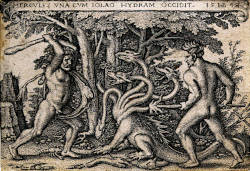Λέρνα
Lerna
Useful Information


| Location: |
Highway 7 at Lerna.
(37.552887, 22.717401) |
| Open: |
No restrictions. [2023] |
| Fee: |
free. [2023] |
| Classification: |
 Karst Spring Karst Spring
 Gateway to Hell Gateway to Hell
|
| Light: | n/a |
| Dimension: | |
| Guided tours: | self guided |
| Photography: | allowed |
| Accessibility: | no |
| Bibliography: |
K.G. Fiedler (1841):
Reise durch alle Teile des königreiches Griechenland in Auftrag der königl. griechischen Regierung in den Jahren 1834 bis 1837,
2 vols., Leipzig.
 pdf
pdf
|
| Address: | Lerna, Εκβολές Λέρνης, Αργολικός Κόλπος, Lerna 212 00. |
| As far as we know this information was accurate when it was published (see years in brackets), but may have changed since then. Please check rates and details directly with the companies in question if you need more recent info. |
|
History
| 1952 | excavation by John L. Caskey reveals Bronze Age remains. |
Description


The spring Λέρνα (Lerna) is a karst spring of the Vauclusian type. An oval lake, rather deep and blue, is the exit of a cave system which drains towards the sea. It is located at the foot of a limestone hill in the narrow coastal plain. After only 320 m the water flows into the sea in the Εκβολές Λέρνης (Lerni Estuary). Around the spring a village grew, which is called Myli. The spring is thus sometimes dubbed Λέρνι Μύλοι (Lerni Myloi, Lerna of Myli). The name Lerna originates the Hattic plural prefix le- plus arinna or arna which means spring, pool, well, or source. In other words, this place is actually named The Springs.
This is not the only spring, there is a second one, a somewhat smaller spring, without a lake, which is also called Λέρνα (Lerna). It is located 100 m to the south, right at the road near the church Άγιος Δημήτριος (Saint Demetrios). As a matter of fact the short river Lerna has two springs of the same name producing two rivers of the same name, which then meet and form a river of - you guessed it - the same name Lerna. It seems, if you talk of both, they are called Πηγές Λέρνης (Fountains of Lerni). We decided to call the northern spring Big Spring and the southern spring Small Spring, but that’s not their actual name. The Small Spring was cased in, so the actual spring is not accessible anymore. We guess it was located where now the parking lot for the church is.
The Lerna Spring is famous for the Lernaean Snake or Lernaean Hydra, or simply the Hydra. The monster was killed by Heracles (Hercules) as the second of his Twelve Labors. The serpentine water monster in Greek and Roman mythology had its lair in the Lake of Lerna in the Argolid. Lerna had numerous springs forming the lake and a marshy area on a geographically narrow point between mountains and the sea. The strong Karst springs remained, the lake, diminished to a silt lagoon by the 19th century, has vanished completely today. It seems Alcyonian Lake is another name of the same lake, and it is described as being extremely deep. This would very well fit a Vauclusian karst spring of considerable size, so we actually guess that they were talking about the spring itself. However, core drilling has identified the site of the vanished sacred Lake Lerna, which had a diameter of 4.7 km.
Lerna was also reputed to be an entrance to the Underworld. Heroes could gain entry to the netherworld via the Alcyonian Lake. According to mythology, Dionysus descended to Hades from here to bring back Semele. The keeper of the gate to the Underworld that lay in the waters of Lerna was the Hydra. Nero tried to measure the depth with ropes made several stades long and fastened together, tying lead to them. But he was not successful.
The Lernaean Mysteries were celebrated here, which were sacred to Demeter. This later transformed to the Λέρναια (Lernaia), an important ancient festival which was celebrated annually in Lerna by the Argives. It took place in the ancient sacred grove that stretched along the banks of the Amymons and Pontinou rivers. According to Pausanias, this holiday was founded by Philammon long before the descent of the Heraklides. During the celebration of the Lernaia, phallic symbols were used. The sacred fire was carried by the Argives from the sanctuary of Pyroneia Artemis, which was located on Mount Krathis. They sacrificed a ram in honor of Pylaochos Hades, and threw its dismembered limbs into a chasm in the area, again a connection to the underworld. The Lernaia were held during the Roman era and until the beginning of the Christian era.
 K.G. Fiedler (1841): The Cave of the Lernaean Serpent
K.G. Fiedler (1841): The Cave of the Lernaean Serpent Search DuckDuckGo for "Lerna"
Search DuckDuckGo for "Lerna" Google Earth Placemark: Big Spring
Google Earth Placemark: Big Spring Lernaean Hydra - Wikipedia (visited: 18-DEC-2022)
Lernaean Hydra - Wikipedia (visited: 18-DEC-2022) Hydra Lernaia (visited: 18-DEC-2022)
Hydra Lernaia (visited: 18-DEC-2022) Index
Index Hierarchical
Hierarchical Countries
Countries Maps
Maps